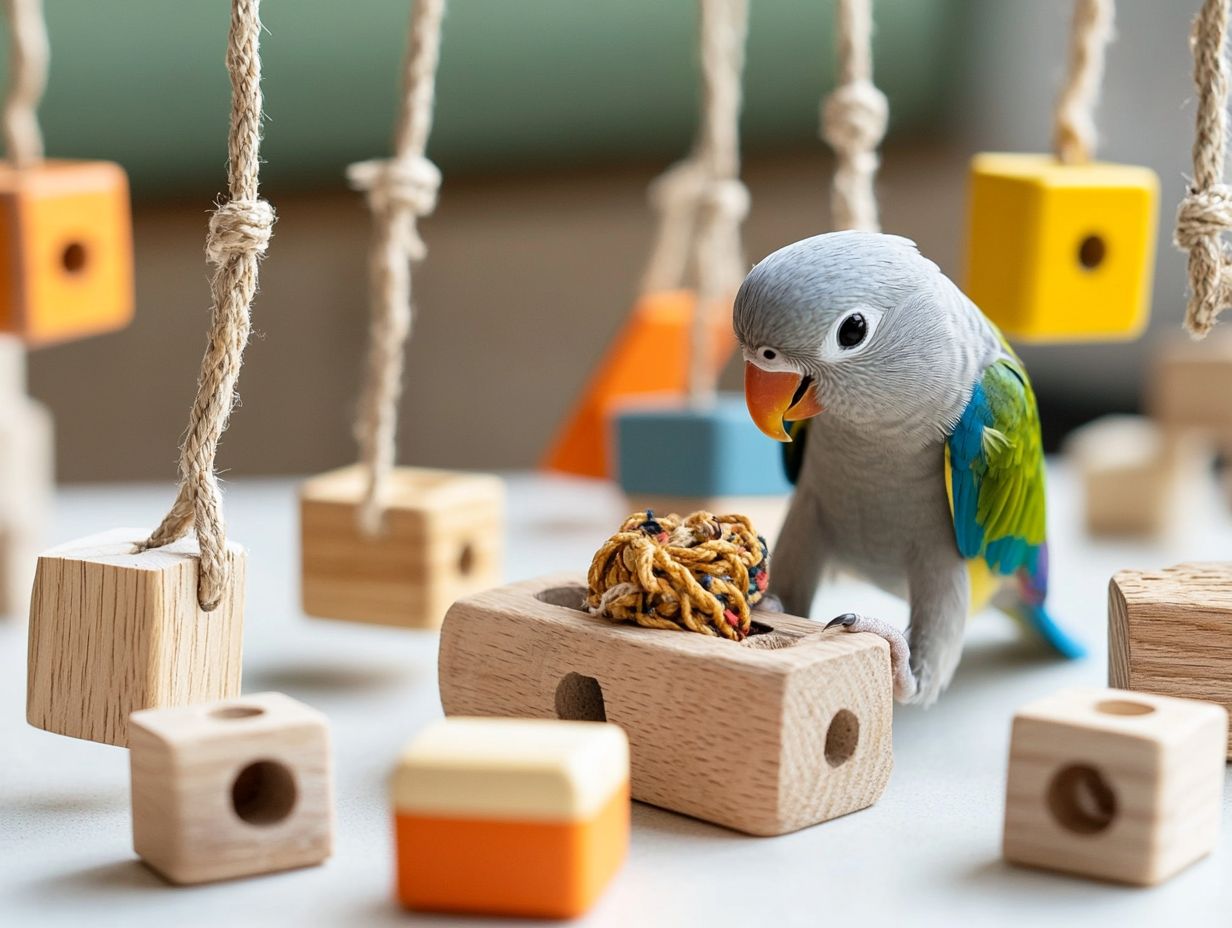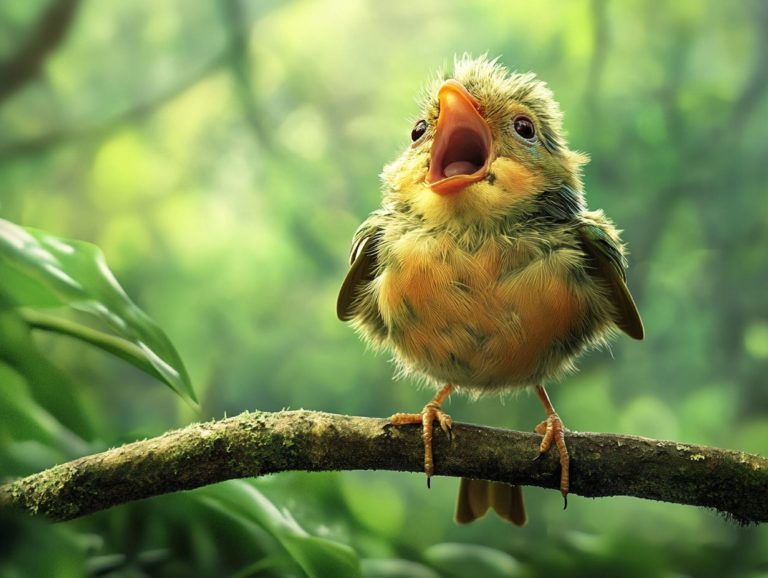How to Choose Safe Bird Toys for Health
Choosing the right bird toys can make a world of difference in your pet’s life. Safe bird toys not only serve as a source of entertainment but also promote thinking skills and physical exercise, contributing significantly to their well-being.
With a plethora of options at your disposal, understanding what constitutes a safe and suitable toy for your bird is key. This guide delves into critical factors such as material, size, and interactive features. It offers valuable tips for selecting the best toys, including foraging toys and chewing toys, ensuring your birds enjoy playtime to the fullest.
Contents
Key Takeaways:

Understanding the Importance of Safe Bird Toys
Grasping the significance of safe bird toys is essential for the well-being of your feathered companions. To ensure their safety, it’s important to learn how to evaluate bird toy hygiene. Birds, especially parrots, thrive on engaging toys crafted from non-toxic materials that stimulate their natural instincts and foster thinking skills.
Opting for safe bird toys, such as those offered by Bonka Bird Toys, ensures your avian friends enjoy both entertainment and a nurturing environment that encourages physical activity and mental enrichment. Selecting the right toys can effectively prevent behavioral issues often stemming from boredom or an uninspiring play space.
Why Choosing Safe Toys is Essential for Your Bird’s Health
Choosing safe toys for your bird is crucial for their health and happiness, as certain materials can pose serious risks. Knowing how to choose safe materials for bird toys can help ensure your feathered friends stay safe and entertained.
By opting for high-quality, non-toxic toys crafted from untreated wood, natural fibers, and stainless steel, you significantly reduce the chances of exposing them to harmful substances. To ensure your bird’s safety, it’s essential to know how to safely clean bird toys and accessories. Unsafe bird toys often contain toxic elements like lead, zinc, or synthetic chemicals, which can lead to serious health issues, including poisoning and digestive problems.
It’s also important to ensure that the toys are free from small parts that could be swallowed or create choking hazards, contributing to a safer environment. For more information, check out this guide on safely using bird toys with multiple birds. Thoughtful selections of safe bird toys not only enhance playtime but actively promote a healthy and secure living space for your avian companions.
Factors to Consider When Choosing Bird Toys
When selecting bird toys, it’s essential to consider several key factors to guarantee safety and suitability for your pet. Pay attention to the materials used, the design of the toys, and the unique needs of your bird. To ensure you’re making the best choices, be aware of the dangers of bird toys. Each detail matters in creating a safe and engaging environment for your feathered friend.
Material and Construction
The materials and construction of bird toys are crucial for ensuring their safety and durability. A range of options like wooden, acrylic, and metal toys are available to you.
Choosing the right materials is key to the well-being of your feathered companions, as non-toxic options help prevent harmful exposures. Wooden toys, for instance, are not only visually appealing but also provide the essential chewing experience that keeps their beaks in top shape. Just be mindful that some untreated woods can pose risks if ingested, so opting for reputable brands like Bonka Bird Toys can guide you towards safer selections, or you can learn more about how to choose safe materials for bird cages.
Acrylic toys offer durability and are a breeze to clean, but they might not satisfy all birds needs for natural textures. It s vital to weigh the advantages and disadvantages of each option while prioritizing safety guidelines to create an enriching environment for your birds.
By choosing the right toys for your bird, you re not just providing entertainment; you’re also ensuring a happier and healthier life for your feathered friend. Start exploring safe options today!
Size and Shape

The size and shape of bird toys are crucial for enhancing your bird’s playtime experience and ensuring their safety.
For instance, smaller birds like budgerigars enjoy toys designed in petite dimensions. Larger species, such as African greys, need more durable options. Choosing toys that fit your bird s beak size and strength is essential for safe interactions.
Beyond safety, the design of these toys encourages physical exercise. Your feathered friend can climb, swing, and chew, fostering both physical health and mental stimulation.
Diverse shapes also invite engagement. Different textures and forms can mimic natural foraging experiences, keeping your birds entertained.
Interactive and Enrichment Features
Interactive features in bird toys are vital for keeping your feathered friends mentally stimulated and physically active.
Engaging elements like foraging and chewing toys enhance thinking skills and promote exercise. Foraging toys let your birds explore and discover hidden treats, tapping into their natural instincts for a fulfilling experience.
Chewing toys provide a way for physical activity and support beak health, ensuring natural wear is maintained.
Incorporating these stimulating toys helps reduce boredom, which can lead to behaviors like feather plucking or excessive squawking. This results in a happier and healthier bird.
Common Hazards in Bird Toys
As a bird owner, you must be aware of common hazards in bird toys that can pose substantial risks to your pet’s health.
Toxic Materials
Toxic materials in bird toys can lead to serious health issues for your pet, making it essential to understand safety from harmful chemicals.
Many bird toys may contain harmful substances like lead and zinc. Ingesting or absorbing these metals can lead to brain injury, kidney problems, and other severe complications.
Be discerning when selecting toys. Ensure they are labeled as safe for birds, avoiding those made from questionable materials or lacking safety certifications. For more guidance, check out how to choose the right size of bird toys.
Choose toys made from natural, untreated materials that are free of potentially toxic chemicals. This proactive approach enhances your pet s health and gives you peace of mind as a responsible owner.
Choking and Entanglement Risks
When selecting bird toys, choking and entanglement risks should be top of mind; awareness of these hazards is essential for your bird’s safety.
Birds, especially smaller species, are curious and love to explore. Thus, it’s crucial to choose toys designed with their well-being in mind.
Opt for toys made from non-toxic materials like hemp and nylon. Avoid items with small parts that could break off or have long strings that could entangle your bird s legs or beak.
Regularly inspect toys for signs of wear and tear to remove anything that could pose a threat. By following these guidelines, you can create a secure and engaging environment for your feathered friends.
Tips for Selecting Safe Bird Toys

Choosing safe bird toys requires your careful attention and thorough research. For more information, refer to understanding bird toy materials and safety to ensure your feathered companions enjoy delightful and secure play experiences, enhancing their well-being and happiness.
Start choosing the best toys today to keep your bird happy and healthy!
Researching Brands and Manufacturers
Researching brands and manufacturers is essential for finding safe bird toys that meet your pet’s specific needs. Evaluate their reputation in the pet industry, as it often reflects their commitment to quality and customer satisfaction.
A reliable brand has a history of prioritizing safety standards. This ensures that all materials are non-toxic and suitable for avian use.
Look into customer reviews for valuable insights about other bird owners’ experiences. This can highlight any concerns or commendations regarding durability and enjoyment. For example, Bonka Bird Toys is a favored choice, known for stringent safety measures and a diverse selection of engaging toys that keep pets entertained and mentally stimulated.
Inspecting Toys for Potential Hazards
Inspect bird toys regularly for potential hazards to ensure a safe play environment for your feathered friends.
Be vigilant for signs of wear, such as frayed edges or chipped surfaces, which can pose significant risks. Check for loose parts that could easily detach and become choking hazards. Always check the materials closely; ensure there are no harmful substances, like toxic paints or hazardous plastics, to safeguard their health.
By following toy safety guidelines, you can reduce the risk of accidents. Allow your birds to enjoy playtime without worry. Inspect your bird’s toys today! Don’t wait safety is key.
Rotating and Replacing Toys Regularly
Rotating and replacing toys is essential for keeping your bird engaged and preventing boredom.
Introduce a fresh selection of captivating toys regularly to create a stimulating environment for your feathered friend. This encourages exploration and play. Birds thrive on variety, and changing their toys can spark their natural curiosity, leading to a more active and enriched life.
This dynamic strategy fosters mental acuity and minimizes wear on individual toys, ultimately extending their lifespan. Your beloved items can stay in the playtime rotation longer, enhancing enjoyment for both you and your bird.
Frequently Asked Questions
How to Choose Safe Bird Toys for Health?

To choose safe bird toys, consider the material, size, and type. Ensure the toy is made from non-toxic and durable materials, appropriate for your bird’s size and species, and provides mental and physical stimulation by following guidelines on selecting safe chew toys for your bird.
What materials should I look for in safe bird toys?
Safe bird toys should be made from natural materials like wood, rope, and leather. Avoid toys with small or easily breakable parts, as they can be choking hazards for birds.
How do I know if a bird toy is appropriate for my bird’s size?
Bird toys must be suitable for your bird’s size and species. A good rule of thumb is to choose a toy larger than your bird’s head to prevent potential choking hazards.
Which toys best stimulate my bird’s mind and body?
Birds are intelligent and active. Choose toys that challenge and engage them both mentally and physically. Puzzle toys, ladders, and swings are great options for promoting stimulation.
Are there any toys I should avoid for my bird?
Avoid toys with sharp edges, toxic materials, or small parts that could be ingested. Also, steer clear of toys with mirrors or reflective surfaces, as they can confuse and stress birds.
How often should I rotate my bird’s toys?
To keep your bird mentally stimulated, rotate their toys regularly. This can be done weekly or even daily. Introduce new toys every few weeks to keep things interesting for your feathered friend.






